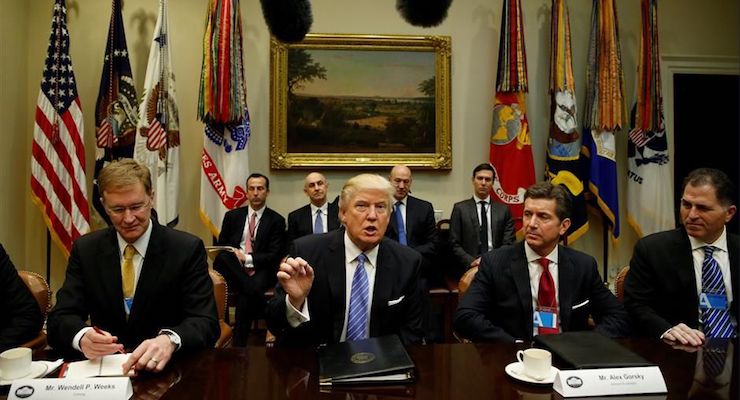

US President Donald Trump hosts a meeting with business leaders in the Roosevelt Room of the White House in Washington on Monday January 23, 2017. (Photo: Reuters)
President Donald J. Trump has signed an executive order aimed at drastically reducing federal regulations, fulfilling a promise he made to both voters and business leaders. The order titled, “Presidential Executive Order on Reducing Regulation and Controlling Regulatory Costs,” represents the implementation of his “one in-two out” proposal that was part of his campaign vow to “Drain the Swamp.”
Read How Reducing Regulations Can Really Help to Drain the Swamp
With the order, the president made it required “for every one new regulation issued, at least two prior regulations be identified for elimination.” Further, the order requires “that the cost of planned regulations be prudently managed and controlled through a budgeting process.”
Put simply, it aims to rescind two regulations for every one that is put in place in the future. Prior to the order and among his first, President Trump also signed a regulatory freeze. The latest round puts the number of orders at more than a dozen in his first 11 days in office. Lawmakers on Capitol Hill have described the president’s pace as “dizzying.”
“We have to knock out a regulation for every two, but it goes far beyond that,” President Trump said in signing the order, after meeting at the White House with a group of small business owners. “We will begin efforts to reduce federal regulations. We’ll be reducing them big time.”
Moving forward, the president’s executive order creates a regulatory budget of $0 for fiscal 2017.
“This is what it will take to finally tackle the federal regulatory beast,” said Club for Growth president David McIntosh. “The regulatory state has run amuck for decades. Now, the agencies and Congress have to get to work and take the lead on repealing costly Obama regulations, and stopping bad regulations in the future.”
[social-media-buttons]
EXECUTIVE ORDER
– – – – – – –
REDUCING REGULATION AND CONTROLLING REGULATORY COSTS
By the authority vested in me as President by the Constitution and the laws of the United States of America, including the Budget and Accounting Act of 1921, as amended (31 U.S.C. 1101 et seq.), section 1105 of title 31, United States Code, and section 301 of title 3, United States Code, it is hereby ordered as follows:
Section 1. Purpose. It is the policy of the executive branch to be prudent and financially responsible in the expenditure of funds, from both public and private sources. In addition to the management of the direct expenditure of taxpayer dollars through the budgeting process, it is essential to manage the costs associated with the governmental imposition of private expenditures required to comply with Federal regulations. Toward that end, it is important that for every one new regulation issued, at least two prior regulations be identified for elimination, and that the cost of planned regulations be prudently managed and controlled through a budgeting process.
Sec. 2. Regulatory Cap for Fiscal Year 2017. (a) Unless prohibited by law, whenever an executive department or agency (agency) publicly proposes for notice and comment or otherwise promulgates a new regulation, it shall identify at least two existing regulations to be repealed.
(b) For fiscal year 2017, which is in progress, the heads of all agencies are directed that the total incremental cost of all new regulations, including repealed regulations, to be finalized this year shall be no greater than zero, unless otherwise required by law or consistent with advice provided in writing by the Director of the Office of Management and Budget (Director).
(c) In furtherance of the requirement of subsection (a) of this section, any new incremental costs associated with new regulations shall, to the extent permitted by law, be offset by the elimination of existing costs associated with at least two prior regulations. Any agency eliminating existing costs associated with prior regulations under this subsection shall do so in accordance with the Administrative Procedure Act and other applicable law.
(d) The Director shall provide the heads of agencies with guidance on the implementation of this section. Such guidance shall address, among other things, processes for standardizing the measurement and estimation of regulatory costs; standards for determining what qualifies as new and offsetting regulations; standards for determining the costs of existing regulations that are considered for elimination; processes for accounting for costs in different fiscal years; methods to oversee the issuance of rules with costs offset by savings at different times or different agencies; and emergencies and other circumstances that might justify individual waivers of the requirements of this section. The Director shall consider phasing in and updating these requirements.
Sec. 3. Annual Regulatory Cost Submissions to the Office of Management and Budget. (a) Beginning with the Regulatory Plans (required under Executive Order 12866 of September 30, 1993, as amended, or any successor order) for fiscal year 2018, and for each fiscal year thereafter, the head of each agency shall identify, for each regulation that increases incremental cost, the offsetting regulations described in section 2(c) of this order, and provide the agency’s best approximation of the total costs or savings associated with each new regulation or repealed regulation.
(b) Each regulation approved by the Director during the Presidential budget process shall be included in the Unified Regulatory Agenda required under Executive Order 12866, as amended, or any successor order.
(c) Unless otherwise required by law, no regulation shall be issued by an agency if it was not included on the most recent version or update of the published Unified Regulatory Agenda as required under Executive Order 12866, as amended, or any successor order, unless the issuance of such regulation was approved in advance in writing by the Director.
(d) During the Presidential budget process, the Director shall identify to agencies a total amount of incremental costs that will be allowed for each agency in issuing new regulations and repealing regulations for the next fiscal year. No regulations exceeding the agency’s total incremental cost allowance will be permitted in that fiscal year, unless required by law or approved in writing by the Director. The total incremental cost allowance may allow an increase or require a reduction in total regulatory cost.
(e) The Director shall provide the heads of agencies with guidance on the implementation of the requirements in this section.
Sec. 4. Definition. For purposes of this order the term “regulation” or “rule” means an agency statement of general or particular applicability and future effect designed to implement, interpret, or prescribe law or policy or to describe the procedure or practice requirements of an agency, but does not include:
(a) regulations issued with respect to a military, national security, or foreign affairs function of the United States;
(b) regulations related to agency organization, management, or personnel; or
(c) any other category of regulations exempted by the Director.
Sec. 5. General Provisions. (a) Nothing in this order shall be construed to impair or otherwise affect:
(i) the authority granted by law to an executive department or agency, or the head thereof; or
(ii) the functions of the Director relating to budgetary, administrative, or legislative proposals.
(b) This order shall be implemented consistent with applicable law and subject to the availability of appropriations.
(c) This order is not intended to, and does not, create any right or benefit, substantive or procedural, enforceable at law or in equity by any party against the United States, its departments, agencies, or entities, its officers, employees, or agents, or any other person.
DONALD J. TRUMP
THE WHITE HOUSE,
January 30, 2017.






